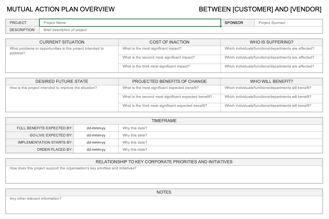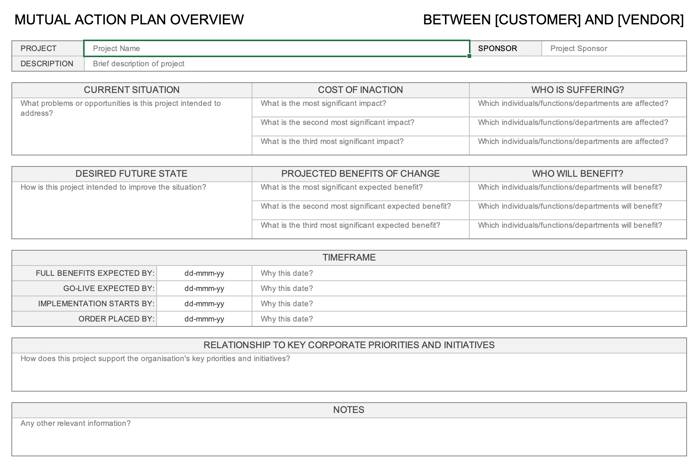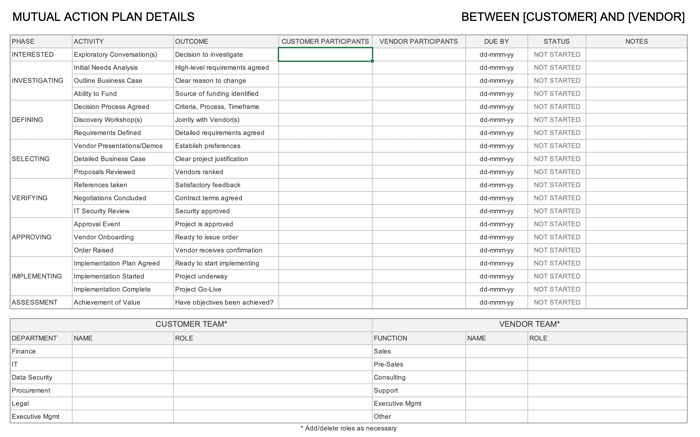 As Gartner and others have frequently pointed out, B2B buying decisions are often complicated. If the problem to be solved is a new one, rather than a familiar repetitive purchase, the buyer (or, more likely, buying group) may not be completely clear about what they want to achieve, or how they need to achieve it.
As Gartner and others have frequently pointed out, B2B buying decisions are often complicated. If the problem to be solved is a new one, rather than a familiar repetitive purchase, the buyer (or, more likely, buying group) may not be completely clear about what they want to achieve, or how they need to achieve it.
Many sales methodologies define a series of steps in the form of a close plan that needs to be completed by the sales person in order to move the sale forward. But unless the prospective customer is engaged in the exercise, these often drive sales activity without guaranteeing any significant progress from the buying side.
This is why Mutual Action Plans are such a powerful concept: they establish mutual agreement between the buyer and seller about the steps they intend to take – individually and jointly – in order to progress the buying journey and make the best possible purchase decision…
But it’s important that we don’t regard the Mutual Action Plan [MAP] as nothing more than a flimsily disguised sales close plan. For the MAP to be effective, it must be structured in a way that enables the customer to complete a successful decision process and – this point is critical – to successfully address the issue that got them interested in the first place.
Stephen R Covey, in his best-selling “Seven Habits of Highly Effective People” promoted the merits of starting with the end in mind – and that’s where any discussion about an effective Mutual Action Plan needs to start.
A Mutual Action Plan – unlike a sales close plan – does not end with the raising of an order. It only ends when the customer acknowledges that that the problem they intended to solve has been addressed and the projected business value has been achieved.
Current Situation and Desired Future State
Before we delve into the detailed activities that underpin an effective Mutual Action Plan, we first need to work with the customer to capture both their current situation and their desired future state and to project the tangible business value that they expect to generate from successfully implementing the solution.
This – in part at least – is an exercise in contrast. We want to help the customer to establish the strongest possible reason for change by identifying their current challenges and defining the consequences of sticking with the status quo on the customer’s organisation, on key functions and departments, and on the key stakeholders who will need to approve the project.
And then we want to compare this to the customer’s desired future state: what would success look like, and how will they measure and justify the business value of achieving it? If – despite our help – our customer cannot clearly articulate the contrast between their current situation and their desired future state, there is strong possibility that they will be unable to make a strong enough internal business case to get the project approved.
Helping them make the best possible decision
Starting with their end in mind also helps to demonstrate that our primary interest is not (unlike “traditional” sales people) to get their order as quickly as possible through fair means or foul, but to help them to make the best possible decision when it comes to solving their problem – even if that means doing something else.
By working backwards from the delivery of value, and by making evidence-driven assumptions about which intermediate steps need to be completed in order for these targets to be met, we also help to bring a sense of urgency to their decision-making process (or prove that their initial hopes and assumptions are way off the mark).
We can then work with them to fill in the detail – stage by stage – of what needs to be accomplished, by when and by whom, in order for these goals to be met. Some of these activities will be done on a joint basis, some will be led by us and some by the customer – but they all need clear ownership and timeframes.
Sharing our experience
Every customer will have their preferences or procedures for the steps that need to be covered, and these of course need to be incorporated into the plan. But it’s also very useful – particularly for relatively inexperienced buyers – for us to introduce key elements that in our experience are necessary in order to ensure that the decision-making process is as effective as possible, and that potential constraints or pitfalls are flushed out as early as possible, rather than emerging as late-breaking impediments to progress.
Mutual Action Plan – overview
A flexible, editable, jointly agreed and regularly framework seems to work best. The overview page of the Mutual Action Plan should:
- Contrast their current situation and desired future state
- Identify the key project milestones working backwards from the confirmation of expected value
- Establish the relationship between this project and the customer’s key corporate priorities and initiatives

Mutual Action Plan – details
The details of the Mutual Action Plan then need to cover:
- Key activities and outcomes by buying phase
- Who will participate from the vendor and customer
- When the activity needs to be completed
- The current status of the activity
- All key members of the customer’s and the vendor’s teams
 In conclusion
In conclusion
I’ve seen remarkable success from implementing Mutual Action Plans. If customers are inexperienced buyers (for the current type of solution at least) they often appreciate the insights. The idea of starting from the delivery of value and working backwards can help them to establish a realistic timeframe.
Incorporating their current situation and desired future state can help bring focus to why the project is important. And when customers struggle to define these things, it can be a sign that either the business case is weak, or that our current prime contact will probably struggle to get approval for the project.
And whilst a customer’s outright refusal to work together on a Mutual Action Plan is not an automatic disqualifier, it should at least cause us to carefully evaluate whether the opportunity is real, whether we have a realistic chance of winning, and whether the effort required will be worth it.
What’s your experience? By the way, if you see a potential role for the persuasive power of Mutual Action Plans within your own sales organisation, please drop me a line.



